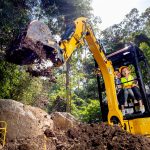Whether you’re on the worksite or jumping into a backyard DIY project, a good pair of workboots can either make or break your time on the tools.
When it comes to choosing your next pair of ‘workies’, there’s no one-size-fits-all. Tradies know all too well that no two jobs are the same, so your boots have to be ready for anything when stepping onto the job.
From dodgy electrical hazards and slippery oil puddles to the classic hammer-to-the-foot, work boots have to be ready to protect you from all kinds of dangers both in and around the worksite.
But with hundreds of different boots now lining the shelves, it’s all too easy to make the wrong choice at the counter. That’s why we’ve partnered up with WorkwearHub and Steel Blue to bring you the tips you need to choose a perfect pair that will have your back every step of the way.
Safety
It might seem obvious, but the most important part of any work boot is its ability to keep you safe when you’re on the tools. Choosing the right type of protection is key to helping you keep all of your digits intact, and it may even save your life.
Think about what kind of dangers you might be walking into with your next job. For example, a composite toe is a great flexible choice for general outdoor construction work, while electrical-resistant shoes would be better suited for high-voltage sparkie jobs.
If you work in the lumber, carpentry, or construction industries, work boots with a hardened composite or steel toe are a must if you want to prevent serious foot injuries.
Support
Good shoe support is an absolute must for any tradie or home hobbyist staring down a hard day on the tools.
When buying your boots, think about the fit of the insole, midsole, shank, puncture plate, and outsole – they make all the difference when it comes to supporting your feet on site.
If you find it tough walking around on the job and have angry-looking blisters forming on your heels, there’s a very good chance you’re rocking the wrong size of work boots.
Comfort, fit, and flexibility
Ask any career tradie about their number one priority for any pair of work boots, and they’ll tell you comfort is king. If you’re prepping for a 12-hour day of hard labour on your feet, knowing your work boots are up to the task can make all the difference in uplifting your spirit and boosting your performance.
When trying on your new pair of work boots, make sure they are a comfortable fit from the outset. Check for any pinching or hot spots since these will likely only get worse as time goes on.
Also, consider the type of material the boots are made out of. Many companies choose to make their boots with leather to give them a tough-but-flexible feel, but they do take some time to break in and require a bit of maintenance to avoid deterioration. Think about what type of material suits your working environment and your cleaning habits.
Insulation and waterproofing
No one likes walking around with waterlogged boots or frozen toes. If you want to dodge a bad case of trench foot this wet season, you’ll need to invest in some work boots with waterproofing and insulation.
Perfect for outdoor work in the unpredictable elements, a good layer of waterproofing can dramatically increase the lifespan of your workboots and improve your overall comfort all year round.
Remember, while many work boots already have waterproofing treatment, nothing lasts forever. Once you’ve worn them for a while, you’ll have to regularly treat your boots every few weeks or months to keep your feet nice and dry on the job.
A slip-resistant sole
An excellent pair of work boots will have a solid grip that leaves you standing on your feet all day round. Slipping, tripping, and falling are a major danger around any worksite and are actually the main cause of injuries for a third of construction workers every year.
There are a lot of outsole varieties on the market to choose from, each offering different levels of grip in different conditions. For example, there are high-performance rubber soles for rough worksite terrains, which tradies grip onto ladders and quickly stop if needed.
If you work at an oil rig or somewhere at risk of chemical exposure, you’ll need to invest in some Thermo Poly Urethane (TPU) outsoles. TPU is a tougher, lightweight alternative to rubber that is designed to withstand oil and other toxic chemicals found around the worksite.
Different types of work boots
While different styles of boots offer all sorts and pros and cons, they can basically be boiled down into three different categories.
Slip-on safety boots
Slip-on safety boots are ideal for construction workers who don’t want to go through the hassle of constantly retying their laces.
However, slip-on boots generally have little ankle support, which is why we wouldn’t recommend wearing them on uneven surfaces such as construction sites. These boots are a better option for warehouse work or for working on flat surfaces.
Lace-up safety boots
Lace-up boots provide much better ankle support and protection, along with a customised fit achieved by the lace. Most sites require you to have lace-up work boots since they’re all-rounders, making them safe for most construction work.
Lace-up with zipping
Lace-up zip boots pack convenience, protection, and comfort into one shoe. While they fulfil all the protection requirements you’ll need at any site, they also make it much easier for you to get in and out of your boots.







